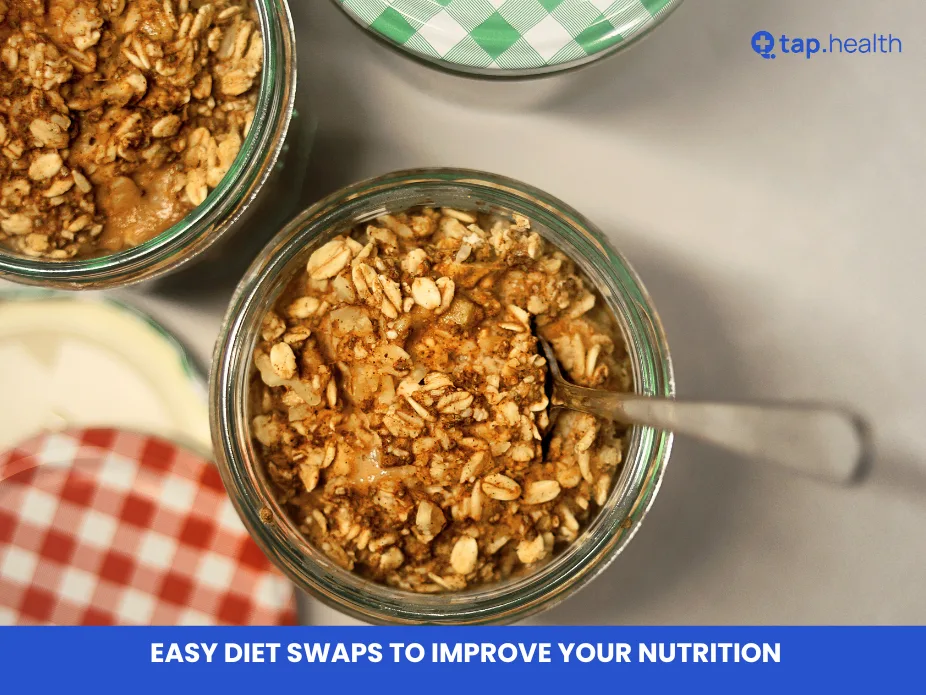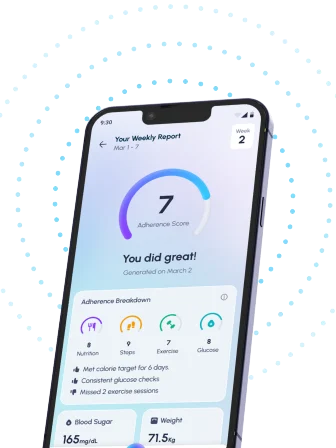Nutrition doesn’t have to be complicated. In fact, making small, easy changes to your diet can have a big impact on your overall health. Whether you’re trying to lose weight, boost your energy, or simply feel better, small diet swaps can help you achieve your goals without drastic changes or deprivation.
In this blog post, we’ll explore simple and effective diet swaps that can improve your nutrition. These changes are based on expert recommendations and backed by research, so you can feel confident that you’re making the right choices for your health.
Real-life scenarios. Expert contributions. Recommendations grounded in proven research and facts. Factual and reliable information.
Why Diet Swaps Matter
Making healthy food choices can seem overwhelming, but the good news is you don’t need to overhaul your entire diet to see benefits. Often, small adjustments can lead to significant improvements in your nutrition and overall well-being.
Diet swaps are all about replacing less nutritious options with healthier alternatives. The goal is to make your meals more balanced and nutrient-dense without adding extra stress to your life.
Whether you’re aiming to increase your intake of essential nutrients, reduce empty calories, or make your meals more satisfying, the following diet swaps can help you achieve your health goals.
Easy Diet Swaps to Improve Your Nutrition
Here are some simple swaps that can make a big difference in your nutrition. We’ve focused on common foods many people consume and offered healthier alternatives that are easy to integrate into your routine.
1. Swap White Bread for Whole Grain Bread
Why it matters: White bread is made from refined flour, which lacks fiber and essential nutrients. Whole grain bread, on the other hand, is made from whole wheat and contains more fiber, vitamins, and minerals. The fiber in whole grain bread helps keep you full longer and supports digestive health.
Real-life scenario: Sarah, a busy mom, used to grab white bread for quick sandwiches for herself and her kids. After switching to whole grain bread, she noticed that she felt fuller after meals, and her kids had more sustained energy throughout the day.
Expert contribution: According to the American Heart Association, whole grains are packed with fiber, which can help reduce the risk of heart disease, diabetes, and high blood pressure.
Swap Tip: Look for bread labeled “100% whole grain” to ensure you’re getting a true whole grain product.
2. Swap Soda for Sparkling Water with a Splash of Lemon
Why it matters: Soda is loaded with sugar and provides little to no nutritional value. It’s also high in empty calories, which can contribute to weight gain and poor metabolic health. Sparkling water with a slice of lemon (or any fruit you like) is a refreshing, low-calorie alternative that hydrates without the added sugar.
Real-life scenario: Mark loved drinking soda with every meal. After switching to sparkling water with lemon, he not only felt less bloated but also lost a few pounds over the course of a month.
Expert contribution: The Centers for Disease Control and Prevention (CDC) recommends reducing sugary drink consumption to improve overall health. Instead, they suggest drinking water or sparkling water for hydration.
Swap Tip: Try adding cucumber, mint, or berries to your sparkling water for extra flavor without the sugar.
3. Swap Regular Pasta for Zucchini Noodles or Whole Wheat Pasta
Why it matters: Regular pasta is made from refined wheat flour, which is low in fiber and can cause blood sugar spikes. Zucchini noodles (also known as “zoodles”) or whole wheat pasta are great alternatives. Zoodles are lower in calories and carbs, while whole wheat pasta provides more fiber and nutrients.
Real-life scenario: Emily, who’s trying to reduce her carb intake, swapped regular spaghetti for zucchini noodles. She found that she felt lighter and had more energy after meals.
Expert contribution: A study published in the American Journal of Clinical Nutrition found that whole wheat pasta is a healthier choice than traditional white pasta due to its higher fiber content, which can help with blood sugar control and improve digestive health.
Swap Tip: Invest in a spiralizer to easily make zucchini noodles, or buy pre-made zoodles from the store if you’re short on time.
4. Swap Fried Foods for Baked or Grilled Options
Why it matters: Fried foods are often high in unhealthy trans fats and added oils, which can contribute to inflammation and increase the risk of chronic diseases. Baked or grilled foods retain more nutrients and can be just as delicious with the right seasoning and preparation.
Real-life scenario: John used to fry chicken wings every weekend. After switching to grilled wings with a simple marinade, he enjoyed the same crispy texture but with fewer calories and less fat.
Expert contribution: The American Diabetes Association recommends grilling, baking, or steaming as healthier cooking methods to reduce unhealthy fat intake and improve heart health.
Swap Tip: Try baking sweet potato fries instead of regular fries for a healthier option.
5. Swap Creamy Salad Dressings for Olive Oil and Vinegar
Why it matters: Creamy salad dressings are often high in unhealthy fats, sugar, and calories. A simple vinaigrette made from olive oil and vinegar provides healthy fats and is much lower in calories. Plus, olive oil contains antioxidants that can support heart health.
Real-life scenario: Lisa, who was trying to eat more salads for lunch, swapped her ranch dressing for a homemade olive oil and balsamic vinegar dressing. She found that her salads were more satisfying and didn’t feel as heavy as before.
Expert contribution: Research published in the Journal of Nutritional Biochemistry found that olive oil is beneficial for heart health due to its monounsaturated fats, which help lower bad cholesterol levels.
Swap Tip: Experiment with adding herbs and spices like garlic, oregano, and Dijon mustard to create a flavorful, healthy dressing.
6. Swap Potato Chips for Air-Popped Popcorn
Why it matters: Potato chips are high in sodium, unhealthy fats, and calories. Air-popped popcorn, on the other hand, is low in calories, high in fiber, and a great source of antioxidants. Plus, it’s easy to make at home.
Real-life scenario: Tom used to snack on a bag of chips every afternoon. After switching to air-popped popcorn with a dash of sea salt, he felt less guilty about snacking and noticed his waistline wasn’t expanding.
Expert contribution: According to the American Heart Association, eating snacks like air-popped popcorn can help reduce your intake of processed foods high in sodium and unhealthy fats.
Swap Tip: Use an air-popper or microwave-safe bowl with a lid to make your own popcorn at home. You can control the seasonings and avoid the added salt and preservatives found in store-bought chips.
7. Swap Regular Yogurt for Greek Yogurt
Why it matters: Regular yogurt contains sugar and fewer protein benefits. Greek yogurt, on the other hand, is thicker, higher in protein, and often lower in sugar. It also contains probiotics, which are beneficial for gut health.
Real-life scenario: Maria swapped her flavored yogurt for plain Greek yogurt with fresh fruit and nuts. She found that the Greek yogurt kept her full for longer and gave her more energy throughout the day.
Expert contribution: According to the National Institutes of Health, Greek yogurt is an excellent source of probiotics, which help support a healthy gut microbiome and boost immunity.
Swap Tip: Choose plain, unsweetened Greek yogurt to avoid added sugar. Add your own fresh fruit or honey for sweetness.
Frequently Asked Questions (FAQ) on Easy Diet Swaps to Improve Your Nutrition
1. Can diet swaps help with weight loss?
Yes! Many of the diet swaps suggested above, like choosing whole grains, reducing sugar intake, and opting for healthier cooking methods, can help reduce overall calorie consumption and improve the quality of your diet. Over time, these changes can support weight loss goals.
2. Are there any diet swaps for improving energy levels?
Absolutely! Swapping processed foods for nutrient-dense options like whole grains, healthy fats (such as olive oil and avocado), and lean proteins can help stabilize blood sugar levels and prevent energy crashes. Also, cutting back on sugary drinks (like soda) and replacing them with water or herbal teas can reduce energy dips.
3. How long does it take to see results from diet swaps?
The results can vary depending on the individual and the specific diet swaps being made. Many people notice improvements in energy levels, digestion, and overall well-being within a few weeks. For weight loss or more noticeable changes, it may take a month or longer.
4. Can I still eat out while making these diet swaps?
Yes! Many restaurants offer healthy alternatives like whole grain bread, grilled proteins, and salads with olive oil-based dressings. Don’t be afraid to ask your server for healthier options or substitutions.
5. Do I need to make all of these swaps at once?
No, you can start by making one or two swaps and gradually incorporate more as you feel comfortable. Small, sustainable changes are often more effective than drastic overhauls.
Conclusion
Improving your nutrition doesn’t require drastic changes or complicated meal plans. Simple diet swaps, like replacing white bread with whole grains or soda with sparkling water, can make a big difference over time. By making healthier choices today, you’re setting yourself up for a better tomorrow.
Remember, consistency is key, and small improvements add up to big results. Take it one swap at a time, and you’ll be on your way to better nutrition and a healthier lifestyle.




